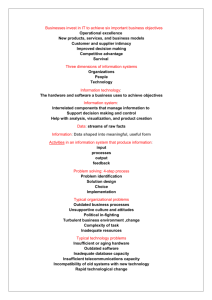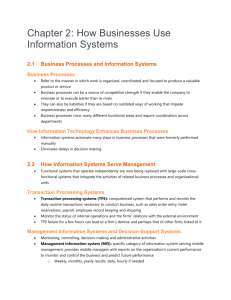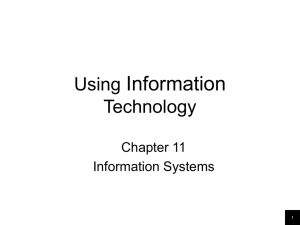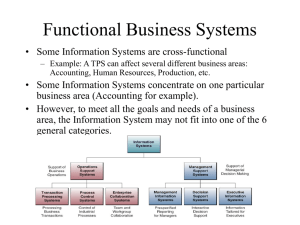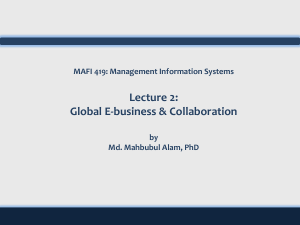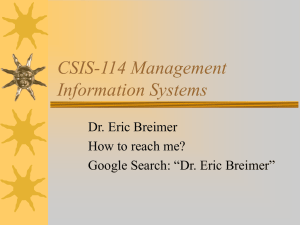Management Information Systems
advertisement
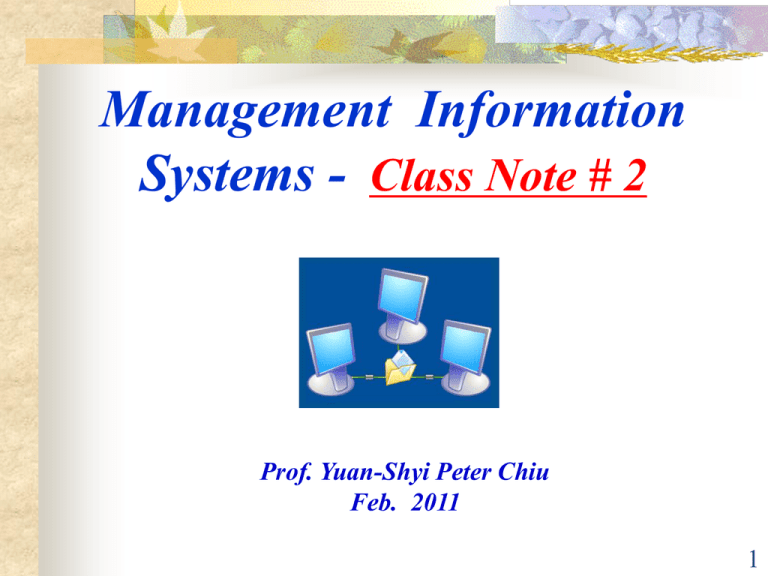
Management Information Systems - Class Note # 2 Prof. Yuan-Shyi Peter Chiu Feb. 2011 1 Chap 2 Information Systems in the Enterprise 2.1 Key System Applications in the Organization 2.2 Systems from a Functional Perspective 2.3 Integrating Functions and Business Processes 2.4 International Information Systems 2 Fig 2.1: Types of Information Systems 3 2.1 Different kinds of systems Operational-level systems Information systems that monitor the elementary activities and transactions of the organization . Knowledge-level systems Information systems that support knowledge and data workers in an organization. 1/2 4 2.1 Different kinds of systems Management-level systems Information systems that support the monitoring, controlling, decision making, and administrative activities of middle managers. Strategic-level systems Information systems that support the long-range planning activities of senior management . 2/2 5 Major Types of Systems • Executive Support Systems (ESS) • Decision Support Systems (DSS) • Management Information Systems (MIS) • Knowledge Work Systems (KWS) • Office Automation Systems (OAS) • Transaction Processing Systems (TPS) 6 Fig 2-2: The six major types of information systems. 7 2.1 Six Major Types of Systems TPS – Transaction Processing Systems Computerized systems that perform and record the daily routine transactions necessary to conduct the business; they serve the organization’s operational level. 8 Fig 2-4: Typical applications of TPS ■ 9 TYPICAL TPS APPLICATIONS Sales & Marketing Systems MAJOR FUNCTIONS OF SYSTEMS: Sales Management ; Market Research ; Promotion ; Pricing ; New Products MAJOR APPLICATION SYSTEMS: Sales Order Info System ; Market Research System ; Pricing System See Fig. 2-4 ( p.43 ) 10 2.1 TPS – Transaction Processing Systems Manufacturing Plant scheduling Material movement control Machine control Finance Securities trading Cash management 11 2.1 TPS – Transaction Processing Systems Accounting Payroll Account payable Account receivable Human Resources Compensation Training & development Employee record keeping 12 2.1 Payroll TPS Fig 2-3: A symbolic representation for a payroll TPS. ◆ 13 2.1 Six Major Types of Systems KWS – knowledge work systems Information systems that aid knowledge workers in the creation and integration of new knowledge in the organization . Example: Engineering work station 14 2.1 Six Major Types of Systems OAS – office automation systems Computer systems, such as word processing, electronic mail systems, and scheduling systems, that are designed to increase the productivity of data workers in the office . 15 2.1 Six Major Types of Systems MIS – Management Information Systems Information systems at the management level of organization that serve the functions of planning, controlling, and decision making by providing routine summary and exception reports. Example: Annual budgeting 16 2.1 MIS • Structured and semi-structured decisions • Report control oriented • Past and present data • Internal orientation 17 TPS DATA FOR MIS APPLICATIONS Fig 2-5: How management information systems obtain their data the from the organization’s TPS . 18 2.1 Six Major Types of Systems DSS – Decision Support Systems Information systems at the management level of an organization that combine data and sophisticated analytical models to support nonroutine decision making. Example: Contract cost analysis 19 Decision Support System (DSS) Fig 2-7: Voyage estimating decision-support system . ◆ 20 2.1 MIS & DSS Sales and marketing Sales management Sales region analysis Manufacturing Inventory control Production scheduling 21 2.1 MIS & DSS Finance Annual budgeting Cost analysis Accounting Capital investment analysis Pricing / profitability analysis Human Resource Relocation analysis Contract cost analysis 22 2.1 Six Major Types of Systems ESS – Executive Support Systems Information system at the organization’s strategic level designed to address unstructured decision making through advanced graphics and communications. Example: 5-year operating plan 23 2.1 ESS • Top level management • Designed to the individual • Ties CEO to all levels • Very expensive to keep up • Extensive support staff 24 Executive Support System (ESS) Figure 2-8 Fig 2-8: Model of a typical executive support system . 25 2.1 ESS Sales and marketing Sales trend forecasting Manufacturing Operating plan Finance Budget forecasting Accounting Profit planning Human Resource Personnel planning 26 2.1 Characteristics of Different Types of Information Systems Information inputs Processing Information outputs Users See Table 2-1 ( p.41 ) 27 2.2 Systems from a Functional Perspective Fig 2-9: Interrelationships among systems 28 2.2 Systems from a Functional Perspective SALES & MARKETING SYSTEMS MANUFACTURING & PRODUCTION SYSTEMS FINANCE & ACCOUNTING SYSTEMS HUMAN RESOURCES SYSTEMS 29 2.2 Systems from a Functional Perspective Sales and Marketing Systems Major functions of systems: Sales management, market research, promotion, pricing, new products Major application systems: Sales order info system, market research system, pricing system 30 Sales and Marketing Systems 31 2.2 Systems from a Functional Perspective Manufacturing and Production Systems Major functions of systems: Scheduling, purchasing, shipping, receiving, engineering, operations Major application systems: Materials resource planning systems, purchase order control systems, engineering systems, quality control systems 32 Manufacturing and Production Systems 33 2.2 Systems from a Functional Perspective Financing and Accounting Systems Major functions of systems: Budgeting, general ledger, billing, cost accounting Major application systems: General ledger, accounts receivable, accounts payable, budgeting, funds management systems 34 Financing and Accounting Systems 35 2.2 Systems from a Functional Perspective Human Resource Systems Major functions of systems: Personnel records, benefits, compensation, labor relations, training Major application systems: Payroll, employee records, benefit systems, career path systems, personnel training systems 36 Human Resource Systems 37 2.3 Business Processes and Information Systems Business processes Manner in which work is organized, coordinated, and focused to produce a valuable product or service Concrete work flows of material, information, and knowledge—sets of activities Unique ways to coordinate work, information, and knowledge Ways in which management chooses to coordinate work 38 2.3 Business Processes and Information Systems Examples of Business Processes Manufacturing and production: Assembling product, checking quality, producing bills of materials Sales and marketing: Identifying customers, creating customer awareness, selling 39 2.3 Business Processes and Information Systems Cross-Functional Business Processes Fig. 2-12 The Order Fulfillment Process 40 2.3 Business Processes and Information Systems Information systems help organizations Achieve great efficiencies by automating parts of processes Rethink and streamline processes 41 2.3 Business Processes and Information Systems Customer Relationship Management (CRM) Manages all ways used by firms to deal with existing and potential new customers Uses information system to coordinate entire business processes of a firm Provides end-to-end customer care Provides a unified view of customer across the company Consolidates customer data from multiple sources and provides analytical tools for answering questions 42 2.3 Business Processes and Information Systems Customer Relationship Management (CRM) Figure 2-13 43 2.3 Business Processes and Information Systems Supply Chain Management (SCM) •Close linkage and coordination of activities involved in buying, making, and moving a product •Integrates supplier, manufacturer, distributor, and customer, logistics, time •Reduces time, redundant effort, and inventory costs •Network of organizations and business processes •Helps in procurement of materials, transformation of raw materials into finished products •Helps in distribution of the finished products to customers • Includes reverse logistics - returned items flow in the reverse direction from the buyer back to the seller 44 2.3 Business Processes and Information Systems Supply Chain Management Figure 2-14 45 2.3 How Information Systems Facilitate Supply Chain Management •Decide when, what to produce, store, move •Rapidly communicate orders •Communicate orders, track order status •Check inventory availability, monitor levels •Track shipments •Plan production based on actual demand •Rapidly communicate product design change •Provide product specifications •Share information about defect rates, returns 46 2.3 Collaborative Commerce Figure 2-15 47 2.3 Enterprise System Figure 2-17 48 2.4 Global System Configuration Figure 2-18 49 HOMEWORK Chap.2 #1 #2 #3 # 7 #8 #9 # 10: What is CRM? # 11: What is SCM? # 12 ~ THE END ~ 50
